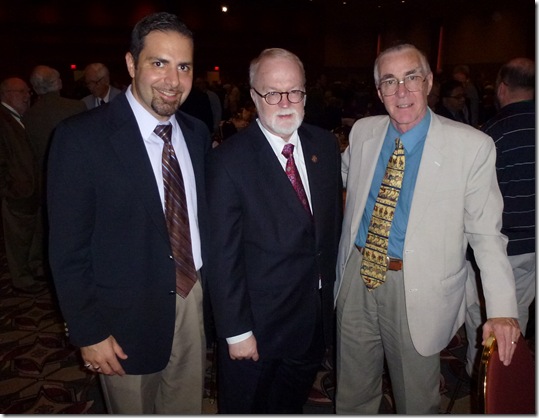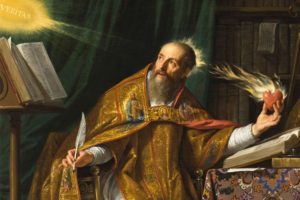Thanks for your prayers last week. After preaching at Sojourn Church in Louisville, followed by a visit to Asbury Seminary, Professor Tony Lane (my doctoral supervisor from London, pictured on the right) and I drove to Milwaukee, Wisconsin for the Evangelical Theological Society annual meeting. It was there I participated in a Journeys of Faith panel with my friends, Frank Beckwith, Gregg Allison, and Lyle Dorsett, et al., enjoyed co-moderating a discussion with Justin Taylor on justification in Luther and Calvin between Tony and Carl Trueman, and, finally, I presented a paper titled “Crossing the Tiber: Why Catholics and Protestants Convert.” After teasing you with the introduction last week, some readers of this blog expressed an interest in seeing the entire paper, which I have posted below. Immediately after the paper was the banquet where Tony and I had the pleasure of sitting beside Timothy George, from whom we learned a great deal about the Vatican’s recent Synod on the New Evangelization.
In April of 2009, The Pew Forum on Religion and Public Life released its so called “Faith in Flux” study, analyzing religious affiliation in the US. The study explains that “One in ten American adults is a former Catholic,” half of whom have migrated toward Protestantism. This amounts to over 15 million people. Two-thirds of these former Catholics belong to Evangelical congregations. That is 10 million men and women who used to sing the Ave Maria, who now prefer something closer to Keith and Krysten Getty.
Unfortunately, the Pew Forum does not identify the number of Protestants who have converted to Catholicism. That there are such people swimming the Tiber is evident by a virtual genre of books on the subject. For example, in 1993, a Presbyterian graduate of Gordon-Conwell, Scott Hahn, published Rome Sweet Home: Our Journey to Catholicism. In 1994, Professor Thomas Howard, an evangelical of notable Protestant pedigree, wrote his story, Lead, Kindly Light, My Journey to Rome. Fast forwarding to 2009, Frank Beckwith, while he was the sitting President of the Evangelical Theological Society, wrote Return to Rome: Confessions of an Evangelical Catholic. In 2011, radio host and columnist, Michael Coren wrote, Why Catholics Are Right. And in the same year, Professor Christian Smith of Notre Dame wrote his story in a how-to book titled: How to Go from Being a Good Evangelical to a Committed Catholic in Ninety-Five Difficult Steps.
While there is no evidence to suggest that this movement to Rome is comparable in size to the 10 million former Catholics who have left for evangelicalism, it is, nonetheless, a significant movement. Most of us are acquainted with someone who has traveled this path. Very often they are brothers and sisters, moms and dads, sons and daughters.
Of the many converts to Catholicism during the modern period, the most notable is arguably John Henry Newman, the 19th Century Anglican divine turned Catholic Cardinal, recently beatified by Pope Benedict XVI. Regarded by many as the eminent and most creative English theologian of the 19th century, Newman is remembered in various ways: leader of the Oxford movement, Victorian sage, educational theorist, poet, satirist, preacher, and forerunner of Vatican II. Library shelves around the globe are weighed down by the several hundred volumes dedicated to his life. Perhaps most of all, however, Newman is known as a convert.
It is noteworthy that the title of Tom Howard’s book, Lead Kindly Light, is taken from Newman’s hymn by the same name.
Lead, kindly Light, amid th’encircling gloom, lead Thou me on!
The night is dark, and I am far from home; lead Thou me on!
Keep Thou my feet; I do not ask to see
The distant scene; one step enough for me.
Newman’s words were originally penned during his visit to Southern Europe in 1833, when he was far from his English homeland and terribly ill. In retrospect, however, he appears to have described his religious journey, which led him progressively to the Roman Church.
In what follows, we will seek to accomplish three things:
1.) To identify the primary reasons why someone like Newman would convert from Protestantism to Catholicism.
2.) To consider why Newman’s questions might lead someone in the opposite direction, that is, from Rome to evangelicalism. Here we will briefly compare Newman to the 16th Century Catholic convert, Peter Martyr Vermigli.
3.) How do these lessons illuminate today’s experience of conversion among Catholics and Protestants?
John Henry Newman
John Henry Newman was born in London in 1801, the eldest of six children. His religious upbringing was of the Bible-based, low-church, Anglican variety.
It was between August and December of 1816 when Newman experienced the first religious turning point of his life. A few months earlier, in March, his father’s bank stopped payment in the aftermath of the Napoleonic wars. Meanwhile, alone at Ealing school and shocked by the financial catastrophe afflicting his family, John Henry became ill.[1] This condition led to Newman’s conversion under the influence of his schoolmaster, the Rev. Walter Mayers, who himself had recently converted to a Calvinistic variety of evangelicalism. Soon enough, Newman was a committed Calvinist, who considered the Pope to be the antichrist, viewing the papal scepter as a blunt instrument for smiting the intellects of the faithful.
Newman’s second turning point occurred in 1827 at the age of twenty-six when for a short while he flirted with liberalism. Increasingly disenchanted by the subjective faith of evangelicals, buttressed by the arid intellectualism of Oriel College, Newman felt increasingly ambivalent toward the objectivity of doctrinal truth. However, another illness soon drove Newman to his knees, followed by the untimely death of his beloved sister, Mary.
Newman’s friendship with John Keble nurtured a growing desire to study the writings of the early Christian fathers such as Athanasius and Jerome. Newman also embraced the conviction that in divine redemption, God extends his grace through material instruments, through religious conventions that extend Christ’s incarnation to the world. This naturally disposed him to a greater appreciation of the sacraments as the necessary, tangible means of Christian faith. Out of this milieu, the famous Tractarian or Oxford Movement was born, with its emphasis upon the authority of apostolic tradition, succession, baptismal regeneration, and the independence of the Church from the State.
Much can say about the Oxford movement. At its core is the belief that the church exists visibly in the world as a Catholic and apostolic body. Newman and his colleagues postulated that the Catholic Church had three proper branches: Orthodox, Roman, and Anglican, all of which growing out of the undivided church of the early centuries. He dismissed Eastern Orthodoxy on account of its union with particular ethnicities and political governments. Standing between Protestantism and Catholicism was Anglicanism, which represented a middle path, a via media, seeking to avoid errors associated with both extremes. Hence, Anglo-Catholicism came of age. But for Newman, there was one more conversion awaiting him, a movement that resulted in his permanent departure from the Church of England.
Newman’s conversion to Roman Catholicism in 1845, like all spiritual conversions, consisted of a “push” and a “pull.” A certain discontent with Anglicanism, which effectively pushed him into the Tiber River, and a thirst for what Catholicism had to offer, which pulled him to the other side. To be sure, he faced obstacles along the way, but none so great as to deter his progress. We will now consider each of these actions in turn: a major push, a pull, and a formidable deterrent which he overcame.
Push
Growing out of his study of the Post Nicene Fathers, Newman grew uncertain about whether Anglicanism could be properly called “Catholic.” Was it truly universal? These doubts took root in 1839, when he read an article by Cardinal Nicholas Wiseman in the Dublin Review in which Anglicans were compared to African Donatists during the time of Augustine—a splinter group that was more parochial than catholic. Reflecting on this question over time, Newman began to correlate the Church of England with the heretical Arians of the fourth century. In Newman’s mind, Anglicanism failed the Catholic test.
Pull
There were several features of Catholicism that attracted Newman: the objective character of sacramental rites, a rich and textured liturgy, clerical celibacy—a discipline to which he had committed himself at a young age, and an authoritative magisterium that transcended British borders. Most of all, perhaps, Newman was attracted to the Catholicity of the Mass.
When he was on his Mediterranean tour in 1832-33, Newman visited Catholic churches in Malta and on the Italian peninsula. Describing this experience, he writes the following:
[W]hen I was abroad, the sight of so many great places, venerable shrines, and noble churches, much impressed my imagination. And my heart was touched. Making an expedition on foot across some wild country in Sicily, at six in the morning, I came upon a small church; I heard voices, and I looked in. It was crowded, and the congregation was singing. Of course it was the mass, though I did not know it at the time. And, in my wary days at Palermo [during my illness], I was not ungrateful for the comfort which I had received in frequenting the churches; nor did I ever forget it….[2]
This is how conversion works. What is at first unfamiliar and off-putting grows on us, and eventually it becomes a value with magnetic force. Such was Newman’s relationship to Catholic liturgy. Writing to an Anglican friend, for example, after his conversion, Newman says:
[I am writing beside the chapel]—It is such an incomprehensible blessing to have Christ in bodily presence in one’s house, within one’s walls, as swallows up all other privileges… To know that [Jesus] is close by—to be able again and again through the day to go in to Him…[3]
An Obstacle
A part of Catholicism that deeply troubled Newman was its sub-biblical “superstition,” religious accretions such as papal primacy, devotion to the Blessed Virgin and the saints, veneration of relics, Purgatory, monastic vows, and the like. For instance, he writes the following impression of the Catholic Church during his visit to Italy as an Anglican:
Oh that thy creed were sound!
For thou dost soothe the heart, Thou Church of Rome
By thy unwearied watch and varied round
Of service, in thy Saviour’s holy name
Ironically, I read this line when I was visiting the Vatican last year. There was so much beauty and meaning surrounding me, if only I could agree with Catholic theology. Well Newman found a way. In his Essay on the Development of Doctrine, which he wrote in 1845, Newman addressed his doubt by reasoning that external religious traditions grow into shape over time, like an acorn that develops into a tree. Similar to Charles Darwin’s work, On the Origin of Species, Newman postulated his theory as an explanation of how a subject might progressively evolve from one state to another. This enabled him to embrace the external elements of Catholic tradition which lacked clear witness in biblical and church history.
So what is the bottom line behind Newman’s conversion? If we were to boil down the motivational factors surrounding his decision, attraction to the sacramental institution would be at the center. No longer would he have to create his ecclesiology as he went along. He jettisoned his via media for a via Romana and found a religious tradition that more convincingly laid claim to the universal scope of Christ’s sacramental presence.
Peter Martyr Vermigli
We now turn our attention to Peter Martyr Vermigli. It may at first seem arbitrary to compare a nineteenth century Englishmen to a sixteenth century Italian. However, upon closer examination we find that Newman and Vermigli have striking parallels.
Vermigli was a nationally recognized Augustinian Canon of the Catholic Church, who became a Protestant Reformer; Newman, a champion of Anglicanism, turned Catholic. Vermigli laid the groundwork of Anglicanism, assisting Archbishop Thomas Cranmer in the composition of the Book of Common Prayer, and gave the movement ongoing input through his disciples such as John Jewel. Newman, on the other hand, pushed Anglicanism in a new catholicized direction.
Significant portions of both men’s lives were spent teaching at the University of Oxford. In fact, they had preaching assignments in the same pulpit at the University church, Saint Mary the Virgin. Immersed in polemics, they both knew the experience of receiving approbation, only to be followed by vigorous opposition and even exile.
Born in Florence, Italy, in 1499, Peter Martyr was named after the 13th century Dominican martyr of Verona. Thus, contrary to what you would naturally assume, our Peter Martyr was in fact not a martyr, but simply named after one. He went against his father’s wishes by joining an Augustine order in 1514. On account of his intellectual promise, he was transferred in 1519 to a monastery near Padua, where he graduated with his Doctor of Divinity in 1526. Immediately after graduation, he was employed as a public preacher at Brescia, Pisa, Venice and Rome; and in his intervals of leisure he mastered the languages of Greek and Hebrew. In 1533 he was sent to lead a monastery in Naples.
In a fascinating turn of events that time will not allow us to describe, Vermigli underwent a theological transformation during his Neapolitan abbacy in which he embraced the doctrine of justification by faith alone, a position that came to be violently opposed by the Catholic Inquisition in 1542, thereby pushing Vermigli into exile north of the Swiss Alps. After five years in Strasbourg with Martin Bucer, Peter Martyr accepted Thomas Cranmer’s invitation to help establish the Reformation in England. Vermigli was appointed Regius Professor of Divinity at Oxford, where he taught for six year until the bloody reign of Queen Mary, which ushered him back to the Continent.
Comparison
With this ever so brief survey of Vermigli, we will now examine the motivational underpinnings of his conversion in terms of his “push” and his “pull,” to see where the lines of continuity and difference fall compared to Newman.
Perhaps the biggest push for Vermigli was Catholic censuring of his biblical preaching. When he exposited 1 Corinthians 3 and suggested that the refining fires by which Christian works are tested refer to something other than the doctrine of purgatory, Vermigli was forbidden to lecture. Although friends in Rome lifted the prohibition, the die was cast. Like Luther before him, Martyr’s conscience was captive to the Word of God.
Vermigli’s ministry revolved around the exposition of Scripture. Hans Asper’s painting of Peter Martyr, which hangs in the National Portrait Gallery in London, testifies to this fact. Inasmuch as one can be captured by a painted portrait, Martyr’s penetrating brown eyes look to the distance beyond the gilded frame while he points to a singular book in his hand: the Bible. If we were to place a statement on Vermigli’s lips, it would perhaps be, as Frank James suggests, his exhortation for youth to study Scripture above all else. In Martyr’s words, “Let us immerse ourselves constantly in the sacred Scriptures, let us work at reading them, and by the gift of Christ’s Spirit the things that are necessary for salvation will be for us clear, direct, and completely open.”[4]
A major pull for Vermigli revolved around the doctrine of salvation, the question of how is one saved. It is commonly believed that this question precipitated his turning point in Naples. It was here, according to Martyr’s biographer, that “the greater light of God’s truth” began to shine upon Vermigli.[5] According to Philip McNair, this light was “the doctrine of justification by Faith alone in a crucified yet living Christ. [McNair goes on to say] The acceptance of this vital doctrine entailed so drastic a reorientation of heart and mind that it amounted to conversion.”[6]
Unlike Newman, who insisted that redemptive grace is dispensed through sacramental acts, as God ordained rites that impart forgiveness, Vermigli grounded God’s saving power in his word, accessed by faith alone. To be sure, Vermigli unites the work of Christ to the sacraments of baptism and the Lord’s Supper; however, the integrity of these sacraments is based not upon the ritual itself, but rather upon the word of God, which the rituals signify. Simply put, Vermigli, like most evangelical Protestants, was motivated by the doctrines of sola scriptura and justification by faith alone.
So how do these men compare: Newman the 19th Century Englishman and Vermigli the 16th Century Italian? When we place their reasons for conversion side by side, where do the lines of continuity and difference fall?
Above all, their continuity consists in a commitment to finding and propagating Christian faith in its most biblically rooted, historically attested, and philosophically coherent form. Such a vision motivated their inquiry and guided their steps, albeit in opposite directions.
If, as I’m suggesting, their aims were analogous, how could Newman and Vermigli reach such diverse conclusions? The answer lies in their answer to a particular question: What is the supreme authority on which Christian faith is properly based: Scripture or the Institution of the Church? This was the crux that distinguished them. Newman sided with the Catholic Church—the sacramental institution with the most convincing claim to universality; Vermigli stood with the text—the living and abiding word of God. It is this same fork in the road that leads Christians today either to Rome or to any number of evangelical Protestant churches.
Having no illusion that my experience or perception of conversion has any sort of exemplary status, I spent two years conducting focus group interviews among former Catholics in the US, at the end of which time I wrote a book titled Holy Ground: Walking with Jesus as a Former Catholic. Of the various lessons uncovered by these interviews, this one, regarding the nature of Christian authority and its implication for salvation, is most fundamental. One becomes a Catholic when he recognizes the sacramental presence of Christ embodied in an institutional church, receiving from it sanctifying grace that leads to salvation. On the other hand, one is an evangelical Protestant when he has embraced Scripture as the supreme authority, coupled with a born again experience that appropriates justifying grace by faith alone.
Conclusion
What principles have we learned from this study?
· Conversion usually consists of many twists and turns. As pilgrims on a journey, we often walk through different seasons of belief before landing on a particular position.
· Conversion is deeply personal. This is true on a vertical plane, since we make discoveries before the face of a personal God. It also happens horizontally, developing our thoughts among colleagues, mentors and friends.
· Personal illness and suffering are often catalysts that motivate us to analyze our beliefs, raise our religious sails, and move in new, sometimes unexpected, directions.
· The entrance point for evangelical Protestants is usually the issue of justification. For Catholics it is the question of how one identifies with the church.
· The destination of one’s conversion is largely connected to the place where he locates apostolic authority. If one recognizes the supreme form of this infallible deposit (on earth) to be in the institution of the church, he will be a Catholic. The one who finds it in the text of Scripture is a Protestant.
· Conversion carries a cost. To the extent that we anchor our conviction in the Catholic or evangelical Protestant traditions, we will inevitably alienate ourselves from certain individuals and communities. It is the cost of discipleship.
In short, journeys of faith are embedded in concrete experiences that are deeply personal, with a definite push and pull, and obstacles along the way. These obstacles are challenges that either keep us contained or catapult us out of a belief system. When a religious position has the power to withstand objections and scrutiny, it undergirds faith as a foundation. On the other hand, when that formulation crumbles in the face of questioning, it becomes a doorway to conversion.
[1] This was the first of three serious illnesses which were accompanied by a profound spiritual crisis. Newman writes, “The first keen, terrible one, when I was a boy of 15, and it made me a Christian—with experiences before and after, awful and known only to God” (Newman, Autobiographical Writings, 150).
[2] The Letters and Diaries of John Henry Newman, ed. Charles Stephen Dessain et al. (London: Nelson, 1961-72; Oxford: Clarendon Press, 1973—) xi, 131.
[3] The Letters and Diaries of John Henry Newman, ed. Charles Stephen Dessain et al. (London: Nelson, 1961-72; Oxford: Clarendon Press, 1973—) xi, 129.
[4]John Patrick Donnelly, trans. and ed. “Exhortation for Youths to Study Sacred Letters” in Life, Letters, and Sermons. The Peter Martyr Library 5. (Kirksville, MO: Thomas Jefferson University Press, 1999). 281
[5] Josiah Simler. Life, Letters, and Sermons. Translated and Edited by John Patrick Donnelly. The Peter Martyr Library 5. (Kirksville, MO: Thomas Jefferson University Press, 1999), 19.
[6] Philip McNair. Peter Martyr in Italy: An Anatomy of Apostasy. (Oxford: Clarendon Press, 1967), 179.





